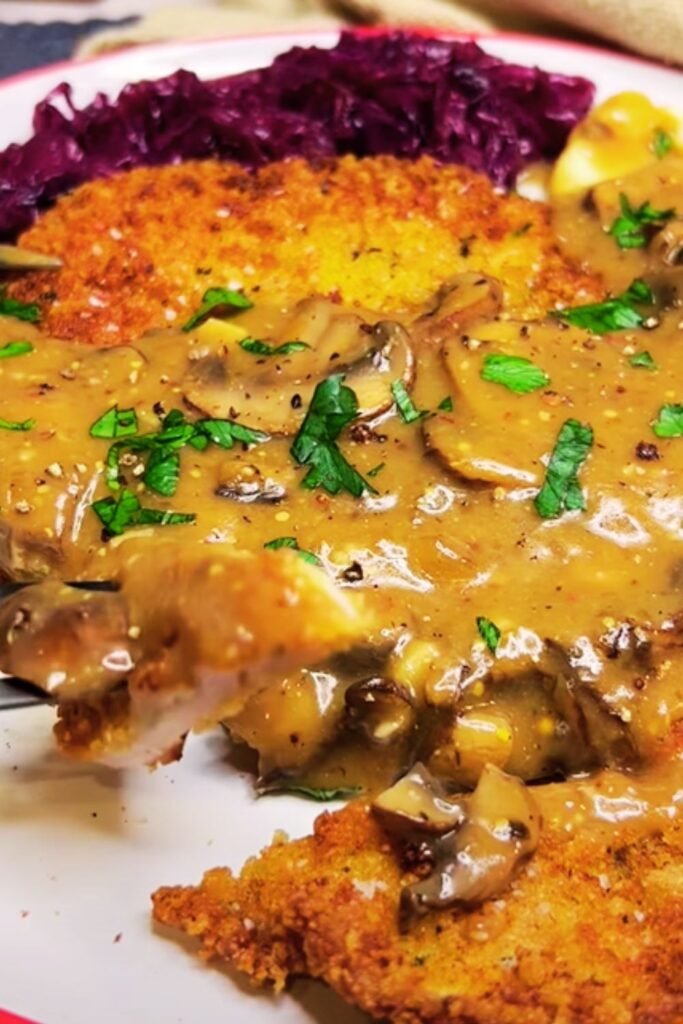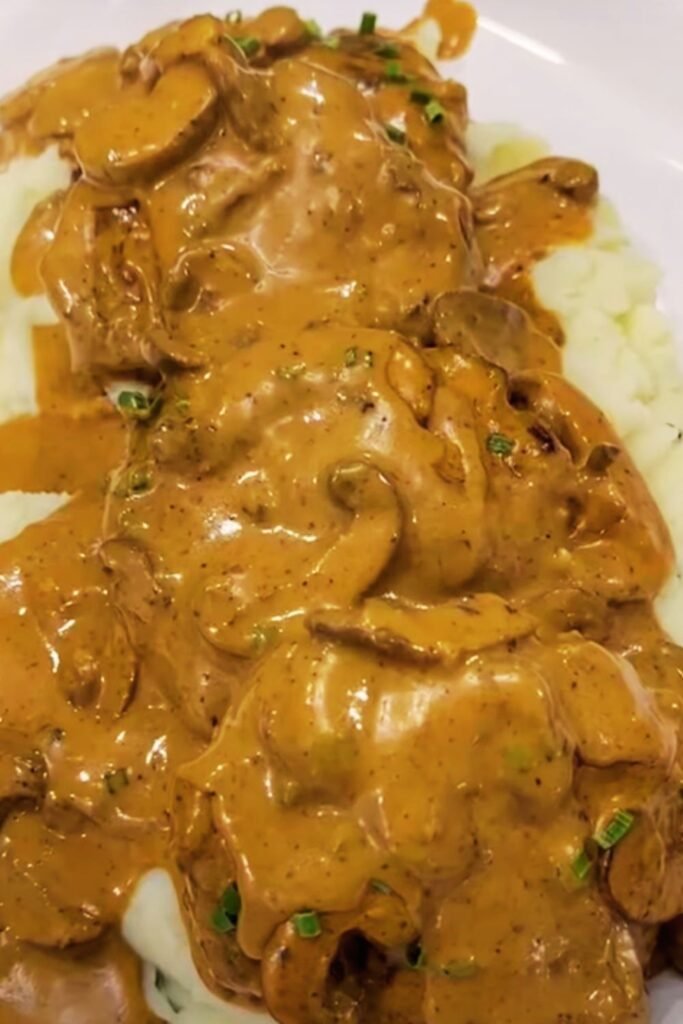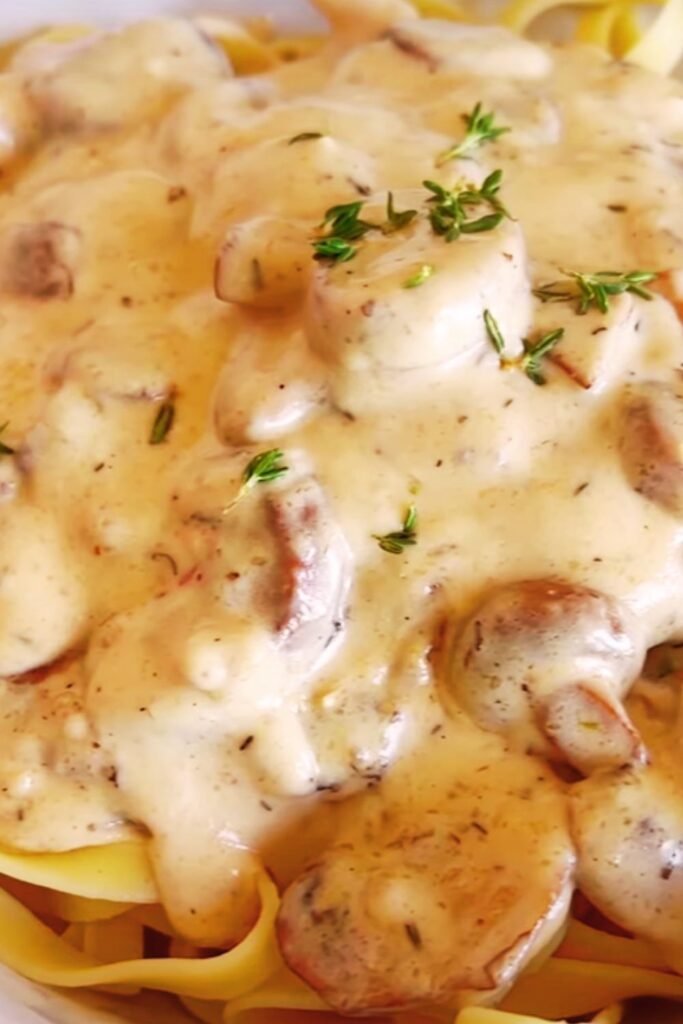I’ve been making mushroom gravy for years, and I can tell you that nothing beats the rich, earthy flavor of a homemade version. This isn’t just another recipe – it’s my go-to method for creating the most luxurious, restaurant-quality mushroom gravy that will transform any meal into something extraordinary. Whether you’re drizzling it over creamy mashed potatoes, smothering a perfectly grilled steak, or adding depth to your holiday dinner, this gravy delivers every single time.
What makes my mushroom gravy special is the attention to detail and the techniques I’ve perfected over countless kitchen experiments. I’ve learned that the secret lies not just in the ingredients, but in how you treat them. From properly caramelizing the mushrooms to creating the perfect roux, every step matters when you’re building layers of flavor that will make your guests ask for the recipe.
Understanding the Science Behind Perfect Mushroom Gravy
Before we dive into the recipe, let me share what I’ve learned about why certain techniques work better than others. Mushrooms contain natural glutamates, which are the compounds responsible for that deep, savory umami flavor we crave. When you properly caramelize mushrooms, you’re not just browning them – you’re concentrating these flavor compounds and creating new ones through the Maillard reaction.
The key to exceptional mushroom gravy lies in understanding moisture management. Mushrooms release a significant amount of water when cooked, and if you don’t handle this properly, you’ll end up with a watery, flavorless gravy. I’ve discovered that cooking the mushrooms in batches and allowing them to properly caramelize before adding liquid creates a foundation of flavor that can’t be replicated any other way.
Temperature control is another crucial factor that many home cooks overlook. When you’re building your roux – that mixture of fat and flour that thickens the gravy – maintaining consistent medium heat prevents burning while ensuring proper development of flavor and color. I’ve burned my share of roux over the years, and I can tell you that there’s no saving it once it’s gone too far.
Essential Ingredient Breakdown
Mushroom Varieties and Their Characteristics:
- Button Mushrooms: Mild flavor, readily available, perfect for beginners
- Cremini Mushrooms: Deeper flavor than button, my personal favorite for everyday gravy
- Portobello Mushrooms: Intense, meaty flavor, excellent for special occasions
- Shiitake Mushrooms: Complex, earthy taste, adds sophisticated depth
- Mixed Mushroom Blend: Combines multiple varieties for maximum flavor complexity
Liquid Components:
- Beef Broth: Provides rich, meaty undertones
- Chicken Broth: Lighter alternative, still flavorful
- Vegetable Broth: For vegetarian versions
- Mushroom Broth: Intensifies the mushroom flavor profile
Thickening Agents:
- All-Purpose Flour: Traditional choice, creates smooth texture
- Cornstarch: Gluten-free option, creates glossier finish
- Arrowroot Powder: Natural thickener, doesn’t break down with reheating
My Perfected Mushroom Gravy Recipe
Ingredients (Serves 6-8)
For the Mushroom Base:
- 2 tablespoons extra-virgin olive oil
- 1 pound mixed mushrooms (cremini, shiitake, and button), sliced ¼-inch thick
- 1 large yellow onion, finely diced
- 4 cloves fresh garlic, minced
- 1 teaspoon kosher salt
- ½ teaspoon freshly ground black pepper
- 2 tablespoons fresh thyme leaves (or 1 tablespoon dried)
For the Roux and Liquid:
- ¼ cup unsalted butter
- ¼ cup all-purpose flour
- 2½ cups low-sodium beef broth, warmed
- ½ cup dry white wine (optional but recommended)
- 2 tablespoons Worcestershire sauce
- 1 tablespoon soy sauce (for extra umami)
- 1 bay leaf
For Finishing:
- 2 tablespoons heavy cream
- 1 tablespoon fresh lemon juice
- Salt and pepper to taste
- 2 tablespoons fresh parsley, chopped

Step-by-Step Preparation Method
Step 1: Prepare Your Ingredients I cannot stress enough how important mise en place is for this recipe. Slice all your mushrooms uniformly – this ensures even cooking. Dice your onion finely so it melts into the gravy rather than creating chunks. Warm your broth in a separate pot; adding cold liquid to hot roux can cause lumps.
Step 2: Caramelize the Mushrooms Heat olive oil in a large, heavy-bottomed skillet over medium-high heat. Add mushrooms in a single layer – work in batches if necessary. This is where patience pays off. Let them sit undisturbed for 3-4 minutes until golden brown on one side. Stir and continue cooking until all moisture has evaporated and mushrooms are deeply caramelized, about 8-10 minutes total.
Step 3: Build the Aromatics Add diced onion to the mushrooms and cook until translucent and slightly caramelized, about 5 minutes. Add garlic, salt, pepper, and thyme, cooking for another minute until fragrant. If using wine, add it now and let it reduce by half.
Step 4: Create the Roux Push mushroom mixture to one side of the pan. Add butter to the empty space and let it melt. Sprinkle flour over the melted butter and whisk to create a smooth paste. Cook this roux for 2-3 minutes, stirring constantly, until it turns light golden and smells nutty.
Step 5: Add Liquid Gradually Gradually whisk in the warm broth, starting with just a splash and whisking vigorously to prevent lumps. Once smooth, add more broth gradually while whisking. Add Worcestershire sauce, soy sauce, and bay leaf. Bring to a simmer.
Step 6: Simmer and Thicken Reduce heat to medium-low and simmer for 10-15 minutes, stirring occasionally, until the gravy coats the back of a spoon. The consistency should be thick enough to coat food but still pourable.
Step 7: Final Seasoning Remove bay leaf. Stir in heavy cream and lemon juice. Taste and adjust seasoning with salt and pepper. The lemon juice brightens the rich flavors and prevents the gravy from tasting heavy.

Nutritional Information and Dietary Considerations
| Nutrient | Per Serving (¼ cup) | Daily Value % |
|---|---|---|
| Calories | 89 | 4% |
| Total Fat | 6.2g | 8% |
| Saturated Fat | 2.8g | 14% |
| Cholesterol | 12mg | 4% |
| Sodium | 345mg | 15% |
| Total Carbohydrates | 6.1g | 2% |
| Dietary Fiber | 1.2g | 4% |
| Sugars | 2.8g | – |
| Protein | 3.4g | 7% |
| Vitamin D | 0.8mcg | 4% |
| Potassium | 245mg | 5% |
Dietary Modifications
Gluten-Free Version: Replace all-purpose flour with equal amounts of cornstarch or arrowroot powder. Whisk the starch with a small amount of cold broth before adding to prevent clumping.
Dairy-Free Version: Substitute butter with olive oil or vegan butter. Replace heavy cream with coconut cream or cashew cream for richness.
Low-Sodium Version: Use low-sodium broth and reduce or eliminate added salt. Increase herbs and spices to maintain flavor complexity.
Vegan Version: Use vegetable or mushroom broth instead of beef broth. Replace butter with olive oil and cream with plant-based alternatives.
Advanced Techniques and Professional Tips
Mushroom Selection and Preparation
I’ve learned that the quality of your mushrooms directly impacts the final result. Fresh mushrooms should feel firm and dry, with no slimy spots or strong odors. I prefer to clean mushrooms with a damp paper towel rather than washing them, as excess water can interfere with proper caramelization.
For optimal flavor, I recommend using a combination of mushroom varieties. Start with cremini as your base – they’re affordable and have excellent flavor. Add shiitake for earthiness and complexity. If you want to splurge, include some oyster mushrooms or even dried porcini that you’ve rehydrated.
Roux Mastery
The roux is the backbone of your gravy, and mastering it separates good cooks from great ones. I’ve found that cooking the roux to a light golden color develops the best flavor without overpowering the mushrooms. White roux (barely cooked) lacks flavor, while dark roux can be bitter and overwhelming.
Temperature control is crucial. If your roux starts to smell burnt or develops dark specks, start over. There’s no saving burnt roux, and it will ruin your entire batch of gravy.
Liquid Integration Techniques
Adding liquid to roux requires patience and technique. I always warm my broth first – cold liquid can cause the roux to seize up and create lumps. Add liquid gradually, whisking constantly. Start with just a splash, whisk until smooth, then add more.
If you do end up with lumps, don’t panic. Push the gravy through a fine-mesh strainer or use an immersion blender to smooth it out.
Troubleshooting Common Problems
| Problem | Cause | Solution |
|---|---|---|
| Lumpy gravy | Cold liquid added too quickly | Strain or blend smooth |
| Too thin | Insufficient thickening or overcooking | Simmer longer or add flour slurry |
| Too thick | Too much flour or over-reduction | Thin with warm broth |
| Bland flavor | Under-seasoned or poor-quality ingredients | Adjust salt, add umami boosters |
| Greasy texture | Too much fat or improper emulsification | Skim excess fat, whisk vigorously |
| Burnt taste | Overcooked roux or too high heat | Start over with fresh ingredients |
Storage and Reheating Guidelines
Proper storage ensures your mushroom gravy maintains its quality and flavor for future meals. I always let the gravy cool completely before storing to prevent condensation, which can make it watery.
Refrigerator Storage: Store in airtight containers for up to 4 days. The gravy will thicken as it cools, which is normal. When reheating, you may need to thin it with a little broth or water.
Freezer Storage: Freeze in portions for up to 3 months. I like to use ice cube trays for small portions that can be easily thawed. Flour-based gravies freeze well, but cream-based ones may separate slightly upon thawing.
Reheating Instructions:
- Stovetop: Heat gently over medium-low heat, whisking frequently. Add liquid if needed.
- Microwave: Heat in 30-second intervals, stirring between each interval.
- From Frozen: Thaw overnight in refrigerator before reheating.

Serving Suggestions and Pairing Ideas
Classic Pairings
Meat Dishes:
- Grilled or pan-seared steaks
- Roasted chicken or turkey
- Pork chops or tenderloin
- Meatloaf or meatballs
- Braised short ribs
Vegetarian Options:
- Creamy mashed potatoes
- Roasted root vegetables
- Stuffed portobello mushrooms
- Vegetarian Wellington
- Polenta or grits
Holiday Applications:
- Thanksgiving turkey
- Christmas roast beef
- Easter ham
- Sunday pot roast
- Holiday stuffing
Creative Applications
I’ve discovered that mushroom gravy works beautifully in unexpected ways. Use it as a base for mushroom risotto, stir it into pasta for an instant sauce, or use it as a filling for savory hand pies. It’s also excellent as a soup base – just thin it with additional broth and add vegetables.
Seasonal Variations and Flavor Profiles
Spring Version
Add fresh herbs like chives, tarragon, and parsley. Include some morel mushrooms if available. The bright, fresh flavors complement spring vegetables perfectly.
Summer Version
Incorporate fresh tomatoes and basil. Use lighter broth and finish with fresh lemon. This version pairs beautifully with grilled foods.
Fall Version
Add sage, rosemary, and a splash of apple cider. Include some dried mushrooms for depth. Perfect for harvest dinners and Thanksgiving.
Winter Version
Use rich beef broth and add a splash of red wine. Include hearty herbs like thyme and oregano. This version is perfect for braised meats and comfort foods.
Equipment and Tools for Success
| Tool | Purpose | Recommended Features |
|---|---|---|
| Heavy-bottomed skillet | Even heat distribution | 12-inch diameter, stainless steel or cast iron |
| Whisk | Smooth roux and sauce | Stainless steel, balloon style |
| Fine-mesh strainer | Smooth texture | 6-inch diameter, double mesh |
| Measuring cups | Accurate measurements | Clear markings, multiple sizes |
| Wooden spoon | Gentle stirring | Long handle, heat-resistant |
| Immersion blender | Emergency smoothing | Variable speed, detachable head |
Frequently Asked Questions
Q: Can I make mushroom gravy ahead of time? Yes, mushroom gravy actually improves in flavor when made ahead. Prepare it up to 2 days in advance and store in the refrigerator. Reheat gently, adding liquid if needed to achieve the desired consistency.
Q: What’s the best mushroom variety for gravy? I recommend cremini mushrooms as the base because they offer the best balance of flavor and affordability. For enhanced flavor, add shiitake or oyster mushrooms. Avoid very delicate varieties like enoki, which break down too much during cooking.
Q: Why is my gravy lumpy? Lumps usually form when cold liquid is added to hot roux too quickly, or when the roux isn’t whisked thoroughly. Always add liquid gradually while whisking constantly. If lumps form, strain the gravy or use an immersion blender.
Q: Can I use different types of flour? All-purpose flour works best for traditional gravy. Whole wheat flour adds nuttiness but can make the gravy darker. For gluten-free options, use cornstarch or arrowroot powder, but reduce the amount by half since they’re more potent thickeners.
Q: How do I fix gravy that’s too salty? Add more liquid (broth or water) to dilute the saltiness. You can also add a small amount of sugar or cream to balance the flavors. In extreme cases, start with fresh ingredients and mix in some of the oversalted gravy gradually.
Q: Can I use canned mushrooms? Fresh mushrooms are always preferable because they provide better texture and flavor. If you must use canned mushrooms, drain them well and sauté them briefly to remove excess moisture before proceeding with the recipe.
Q: What wine pairs well with mushroom gravy? Dry white wines like Sauvignon Blanc or Pinot Grigio complement the earthy mushroom flavors without overwhelming them. Red wines can be used but may make the gravy darker and more intense.
Q: How can I make my gravy more flavorful? Enhance flavor by properly caramelizing the mushrooms, using high-quality broth, adding umami boosters like soy sauce or Worcestershire, and finishing with fresh herbs and a splash of acid like lemon juice.
Q: Is it possible to make mushroom gravy without butter? Absolutely. You can use olive oil, avocado oil, or even rendered bacon fat. Each will impart its own flavor profile to the gravy. Olive oil creates a lighter taste, while bacon fat adds richness and smokiness.
Q: Can I double or triple this recipe? Yes, but you may need to adjust cooking times and use a larger pan. When scaling up, be especially careful with seasoning – taste and adjust gradually rather than simply doubling the salt and spices.
Q: What’s the secret to restaurant-quality mushroom gravy? The secret lies in proper technique: caramelizing the mushrooms thoroughly, building a proper roux, using quality ingredients, and finishing with fresh herbs and acid. Restaurant chefs also often use a combination of different mushroom varieties and high-quality stocks.
Q: How thick should mushroom gravy be? The ideal consistency is thick enough to coat the back of a spoon but still pourable. It should flow easily but not be watery. Remember that gravy thickens as it cools, so err on the side of slightly thinner while hot.
Final Thoughts on Mastering Mushroom Gravy
Creating exceptional mushroom gravy is both an art and a science. I’ve shared my years of experience and the techniques that have never failed me, but remember that cooking is personal. Taste as you go, adjust seasonings to your preference, and don’t be afraid to experiment with different mushroom varieties or flavor additions.
The most important thing I’ve learned is that good mushroom gravy starts with properly caramelized mushrooms and a well-made roux. Master these fundamentals, and you’ll be able to create gravy that rivals any restaurant. Whether you’re making a simple weeknight dinner special or preparing for a holiday feast, this mushroom gravy will elevate your meal and have everyone asking for seconds.
Remember, the best gravy is the one that brings people together around your table. Take your time, enjoy the process, and savor the incredible aromas that fill your kitchen. That’s what cooking is all about – creating not just delicious food, but memorable experiences that last long after the last bite.